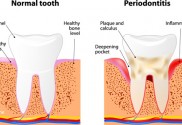Squid Ink to Replace Dental Probes for Periodontal Disease?
- Jason Schwartz
- Sep 4, 2017
A nanoengineer in San Diego says he’s got a possible solution to painful probing for periodontal disease. It involves imaging gums after patients swish around a mouthful of squid ink.
Jesse Jokerst, a professor at the University of California, San Diego, whose research includes finding new medical uses for ultrasound, was at his dentist getting scraped, poked, and prodded when he realized there just had to be a better way.
“These tools are really old,” he said. “Have you seen a periodontal probe? It’s just a metal stick.”
For decades, the gold standard for measuring periodontal disease has been to use those hook-shaped sticks to measure “pocket depth” — the gaps between the gum and the tooth that deepen in people with disease. The process is not something patients — or dentists — like.
In a paper published in the Journal of Dental Research, Jokerst and colleagues describe a non-invasive method to measure pocket depth using high-resolution photoacoustic ultrasound, which uses a short burst of light from a laser to create acoustical pressure waves.
The ultrasound is used after a swish of squid ink — an extremely dark liquid full of melanin nanoparticles that absorbs a lot of light. When hit with a laser, squid ink in the mouth heats up and swells, creating pressure differences in the gum pockets that the ultrasound can easily detect, Jokerst said.
The work was conducted on pig jaws, but clinical trials in humans are now being planned. The squid ink, which actually comes from the cuttlefish, a close squid cousin, is the same type used in cooking — to make squid ink pasta, for example — so it is safe for consumption. And it does not stain teeth and comes off easily with brushing, Jokerst said.
For full article, click here.





